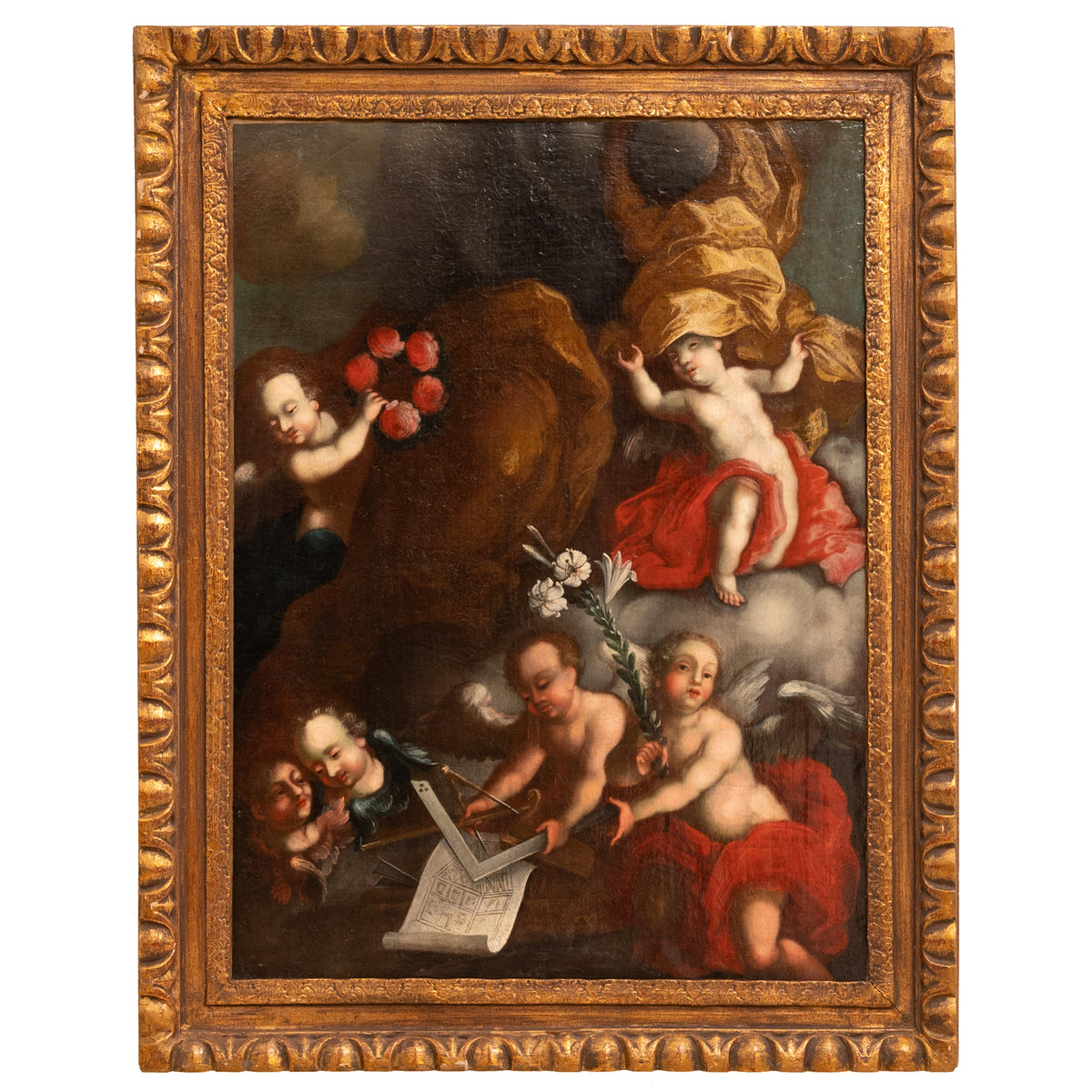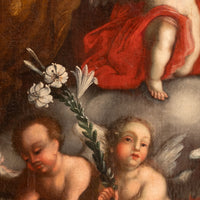Austrian Old Master Baroque Oil on Canvas Painting Architecture Allegory Cherubs Franz Xaver Karl Palko 1750
- Regular
- $ 6,995
- Sale
- $ 6,995
- Regular
- Unit Price
- per
An important & large oil on canvas Baroque painting by the Bohemian Old Master artist, Franz Xaver Karl Palko (1724-1767), an allegory of architecture, circa 1750.
The painting depicts a heavenly scene with a host of cherbs, some hold floral arrangements, the cherbs with their modesty covered with sheets of silk. To the lower part of the painting there are two cherubs, one cherub with a square & compass and a sketch of a timbered house.
The painting is housed in a chip-carved gilded wooden frame, the painting is in very good condition and is ready to grace your wall.
Provenance; From an important private collection, Italy.
Palko's training took place in the family workshop, and at the Academy of Fine Arts in Vienna, but it was his stay in Venice that defined his style and passion for theatrical scenography. In 1754 he created the decoration, unfortunately destroyed, of the Chapel of St. John of Nepomuk in the Court Church of Dresden and then settled in Prague, where he painted the vault with the legend of the saint and an altarpiece in St. John of Nepomuk, and then moved to Zbraslav in Cistercian abbey to work on the summer refectory with the 'Multiplication of the Loaves'. Palko is considered as the most important artist active in Bohemia in the middle of the 1700s.
Franz Xaver Karl Palko (3 March 1724, Breslau - c. 1767, Prague) was a Silesian painter; known primarily for religious scenes, although he also did portraits and engravings.
He was the son of a painter named Anton Palko (died 1754), about whom little is known. he began his studies at home, then went to Vienna, where he studied at the Academy of Fine Arts. In the 1740s, he was enrolled at the Accademia di Belle Arti di Venezia and came under the influence of Giuseppe Crespi. After returning, he worked in Bratislava, Kroměříž and Brno; finally settling in Dresden, where he painted frescoes depicting the life of Saint John of Nepomuk.
In 1752, he was appointed a court painter for the Electorate of Saxony, but moved on to Prague before a year was over, having received a commission from the Society of Jesus to paint frescoes at St. Nicholas Church. However, the Painter's Guild protested, noting that he was neither a guild member nor a citizen of Prague and was therefore undesirable. The following year, a Magistrate ruled that he could finish his work, on the grounds that being a court painter was equivalent to guild membership.
He never became a citizen of Prague, but stayed there for many years. Most of his works appear to have been frescoes or altarpieces. At some point, he was married, as there are baptismal records for a son, Jan Xaver, dating from 1756. The mother's name is given as Marie Anna Bursch, from Saxony.
Exact information regarding his death is not available. He apparently died in Prague in 1767, although other sources indicate that he moved to Munich in hopes of becoming a court painter for the Electorate of Bavaria, but was unsuccessful and died there, in poverty, in 1770.
His brother, Franz Anton Palko was also a well-known painter.
Framed: 44.25" tall x 32.75" wide x 1.5" deep
At sight: 33.75" tall x 25.25" wide
Imperial
ches high × ches wide × ches deep
Metric
high × wide x deep
Displayed rates are for shipping in the Continental U.S. and Canada. For other locations, kindly contact us and we will provide the most competitive shipping price available. All shipments are professionally packed and shipped insured with full tracking capabilities. Customers are also welcome to collect their items from our warehouses or arrange their own shipping.


























